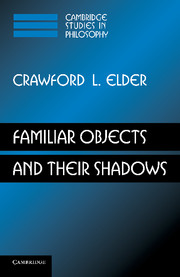Book contents
- Frontmatter
- Contents
- Acknowledgments
- Introduction
- 1 Two false friends of an ontology of familiar objects
- 2 Conventionalism as ontological relativism
- 3 Realism about material objects: persistence, persistence conditions, and natural kinds
- 4 Ontological preference for the temporally small
- 5 Ontological preference for microphysical causes
- 6 Ontological preference for the spatially small
- 7 A third false friend of familiar objects: universal mereological composition
- 8 Concluding Hegelian postscript
- Appendix: “Mutually interfering” dimensions of difference
- References
- Index
1 - Two false friends of an ontology of familiar objects
Published online by Cambridge University Press: 25 January 2011
- Frontmatter
- Contents
- Acknowledgments
- Introduction
- 1 Two false friends of an ontology of familiar objects
- 2 Conventionalism as ontological relativism
- 3 Realism about material objects: persistence, persistence conditions, and natural kinds
- 4 Ontological preference for the temporally small
- 5 Ontological preference for microphysical causes
- 6 Ontological preference for the spatially small
- 7 A third false friend of familiar objects: universal mereological composition
- 8 Concluding Hegelian postscript
- Appendix: “Mutually interfering” dimensions of difference
- References
- Index
Summary
Judgements asserting one or another of two kinds of sameness are crucial, I shall argue, both for our practical mastery of the world and for our theoretical understanding of it. On the one hand, there are judgements saying that one object is the same in kind as other objects, or that some matter is the same in kind as matter found elsewhere. On the other hand, there are judgements saying that the object in front of us is numerically the same object, or that the matter is the very same matter, as we encountered earlier or will encounter later.
In making these judgements we call upon observation and understanding. In order to affirm sameness in kind, we must observe that various similarities obtain between one object and others, or between matter here and matter elsewhere. In order to affirm persistence across a single episode of observation, we must observe that an object (or some matter) has moved continuously, while retaining largely the same features, and in order to affirm persistence across separate episodes, we must observe that the object (or the matter) now before us presents features appropriately related to those observed in an object (or some matter) encountered at other times. But we must also understand which sorts of similarities indicate sameness in kind, which sorts of relations mark out persistences.
- Type
- Chapter
- Information
- Familiar Objects and their Shadows , pp. 7 - 29Publisher: Cambridge University PressPrint publication year: 2011



